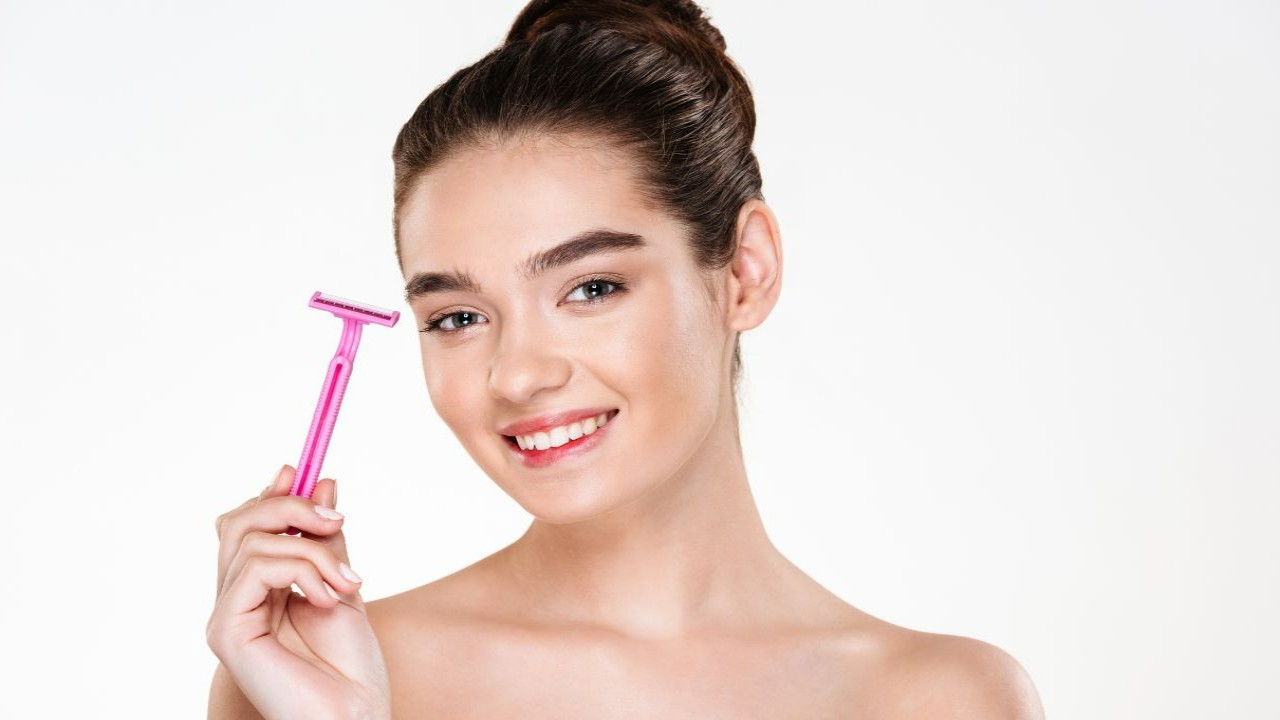Face Shaving for Women: Benefits, Dos And Don’ts for Smoother Skin
Discover the benefits of face shaving for women here. Learn how to shave your visage safely with our expert tips and techniques to get the perfect face card!

Face shaving for women might seem like a radical beauty move at first glance, but it’s actually gaining traction as a game-changing skincare technique. Initially, it might appear a bit unconventional or even a tad risky, raising concerns about safety and effectiveness. However, when done correctly, face shaving can be a valuable addition to your grooming routine. It helps create a smooth, radiant canvas for makeup application and can significantly enhance the effectiveness of your skincare products.
In this article, we’ll explore the benefits of face shaving, debunk myths, and provide you with a comprehensive guide on how to shave your face safely and effectively. We’ll cover the dos and don’ts, from choosing the right tools to prepping your skin and handling post-shave care. Whether you’re a seasoned pro or new to the concept, scroll on to uncover the details and learn how to integrate face shaving into your beauty regimen while keeping your skin healthy and glowing.
Is Face Shaving Good For Women?

Face shaving and dermaplaning are often confused but are not the same. Face shaving, typically done with external razors, removes both dead skin cells and fine hair, leading to a smoother complexion. Dermaplaning, on the other hand, is a specific exfoliation technique performed with a sterile surgical scalpel. It exclusively targets the removal of dead skin cells and fine vellus hair, enhancing skin texture and radiance. While both methods can improve skin appearance, dermaplaning is a more controlled procedure designed specifically for exfoliation, whereas face shaving can be done with various tools and may not always provide the same precision.
Face shaving can be beneficial for women, offering a smoother, more radiant complexion and better makeup application. However, it's essential to use proper tools and techniques to avoid irritation or unwanted side effects.
Why Should Women Shave Their Face?

Women might choose to shave their faces for several reasons. Shaving, or dermaplaning, exfoliates the skin by removing dead cells and fine vellus hair, which can lead to a smoother, more radiant complexion. This process helps improve the effectiveness of skincare products and provides a better surface for makeup application.
Additionally, regular shaving can reduce the appearance of fine lines and promote cell turnover. It's crucial to use appropriate tools and techniques to prevent irritation or damage. Overall, face shaving can be a beneficial part of a skincare routine for those seeking a refreshed and polished look.
Read More: How Many Calories Does Yoga Burn? Decoding Yoga for Weight Loss
What Are the Best Ways to Shave Facial Hair?
Shaving facial hair effectively requires a combination of the right tools and techniques to ensure a smooth, irritation-free experience. Here’s a detailed look at the best ways to achieve this:

1. Choose the Right Tool: For a close shave, many people opt for a sharp razor designed specifically for the face, like a facial razor or a safety razor. These tools help remove fine vellus hair and dead skin cell layers.
Alternatively, electric trimmers can be handy for a quicker, less precise shave. For those considering dermaplaning, a sterile surgical scalpel is used by professionals to carefully exfoliate the skin and remove hair.
2. Prep Your Skin: Preparation is crucial. Start by cleansing your face with a gentle cleanser to remove any dirt and oil. This step helps prevent clogged pores and prepares your skin for a closer shave. For extra softness, you might want to apply a warm, damp towel to your face for a few minutes before shaving. This softens the hair and opens up the pores, making the shaving process smoother.
3. Use a Shaving Cream, Foam Or Gel: Applying a shaving cream or gel creates a protective layer between your skin and the razor, reducing friction and minimizing the risk of razor bumps. Look for products designed for sensitive skin to avoid potential issues. Make sure to apply the cream in a circular motion to lift the hair and create a smooth surface.
4. Hold Your Skin Taut: To effectively remove unwanted hair while also preventing skin damage and lesions, it is essential to hold the skin taut in the direction in which you’ll be shaving.
5. Shave in the Right Direction: Shave in the direction of hair growth to prevent ingrown hairs and reduce irritation. Use light strokes at a 45-degree angle. Avoid pressing too hard on the skin with the razor as this can cause severe skin irritations. If you’re using a straight razor, make sure to maintain a steady hand and follow the natural contours of your face.
5. Avoid Areas with Severe Acne Or Skin Conditions: If you have sensitive or acne-prone skin, ensure you avoid skin eruptions, active acne, dry patches, milia, warts, and other lesions from getting in contact with the razor, thereby preventing damage to the skin.
6. Rinse Frequently: Rinse the razor often during shaving to clear away hair and shaving cream buildup. This ensures a cleaner shave and helps maintain the razor’s effectiveness.

7. Post-shave Care: After shaving, rinse your face with cool water to close the pores and pat your skin dry with a clean towel. Apply a soothing aftershave or moisturizer to help calm the skin and lock in hydration. Avoid products with alcohol, as they can cause dryness and irritation. Also, avoid using skincare products with harsh actives to prevent skin irritation right after shaving.
8. Maintain Your Tools: Keep your razors and tools clean and replace them regularly to ensure they stay sharp and effective. Right after use, dip the razors in warm water infused with a few drops of antiseptic liquid to get rid of any harmful germs. Then, wipe it dry with a clean towel.
A dull blade can cause more irritation and less effective shaving, so, keep changing your dermaplaning tools after every 5-6 uses.
Shaving facial hair can be a great way to achieve a smooth complexion and enhance your skincare routine. With the right approach and tools, you can enjoy the benefits of a fresh, clean look while minimizing discomfort and irritation.
The Dos And Don'ts Of Face Shaving
The Dos

1. Prep Like a Pro: Think of your face as a canvas. Cleanse and soften it with a warm towel. This preps the skin, so it’s as smooth as a freshly waxed floor.
2. Use the Right Tool: Go for a sharp razor with a single blade, designed for the face. Also, ensure it is a clean razor without any germs, dirt, or rust on it. Avoid using regular multi-blade razors that are typically used to remove body hair as they can be too harsh for the facial skin. Safety razors are great, but electric trimmers work wonders for a quick fix. It’s like choosing the right brush for your masterpiece.
3. Apply Shaving Cream Generously: Slather on a good shaving cream or gel. It’s your face’s armor against the blade, and trust me, no one likes a scraped-up battlefield.
4. Shave in the Direction of Hair Growth: Always shave with the grain rather than against the grain to prevent inflaming the hair follicles. It’s like following the yellow brick road — easier and way more comfortable.
5. Rinse And Replace: Keep that razor clean and fresh. Rinse it frequently to prevent gunk buildup. A clean blade is a happy blade!
6. Moisturize Post-shave: After your shave, treat your face to a soothing moisturizer. It’s like giving your skin a spa day after a workout.
The Don’ts

1. Don’t Shave on Dry Skin: Skipping the prep? Big no-no! Shaving dry is like running a marathon without warming up — ouch!
2. Don’t Use Dull Razors: A dull blade is a recipe for irritation. It’s like trying to cut a steak with a butter knife — frustrating and ineffective.
3. Don’t Shave Against the Grain: Going against hair growth might sound adventurous, but it’s a fast track to razor burn and ingrown hairs. Stick to the path, my friend.
4. Don’t Rush the Process: Hasty shaving can lead to nicks and cuts. Take your time and savor the moment — it’s not a sprint, it’s a marathon of grooming.
5. Don’t Overdo It: Daily shaving can be too much for some skin types. Give your face a break if it starts feeling irritated or overly sensitive.
6. Don’t Skip Aftercare: Neglecting to moisturize or applying alcohol-based products can dry out your skin. Think of aftercare as the finishing touch on your facial masterpiece.
By following these quirky yet professional dos and don’ts, you’ll keep your face looking fresh and feeling great.
Read More: Causes And Treatment for Pimple in Ear: Know its Types And Home Remedies
Benefits Of Face Shaving for Women

Face shaving for women is like giving your skin a VIP pass to smoothness and glow! First up, you’ll enjoy a complexion so smooth it could charm a silk sheet — goodbye to pesky peach fuzz and hello to a radiant canvas.
With all that dead skin, unwanted peach fuzz, and terminal hair out of the way, your makeup will go on like a dream, sticking better and looking flawless. Plus, shaving can boost the effectiveness of your skincare products, letting those serums and creams penetrate deeper. It’s like giving your skincare routine a turbo boost!
Moreover, facial hair removal prevents dirt and bacteria from accumulating in the peach fuzz, thereby preventing pesky skin issues such as pimples and blackheads.
In some trending reels and expert reviews, many mention that shaving may also promote cell turnover, so you’re always sporting that fresh-faced glow. In short, face shaving isn’t just a quick fix; it’s like hitting the refresh button for your face.
Read More: Benefits of Papaya for Skin: Uses, Ways to Use, And Precautions
Side Effects of Face Shaving for Women

We all hope to reap the best benefits of face shaving. However, face shaving can sometimes have side effects. Problems can arise when you apply too much pressure on the razor, shave the same skin area multiple times, shave against the grain, or use a blunt or rusted razor.
In such cases, the following issues are likely to occur.
1. Irritation And Redness: Shaving can sometimes cause irritation or redness, especially if your skin is sensitive. It’s a bit like getting a sunburn from a light sunbath — uncomfortable and noticeable.
2. Razor Burn: This happens when your skin reacts to the friction of the razor, leading to a rash or burning sensation. It’s akin to the feeling of accidentally rubbing a sunburn.
3. Ingrown Hairs: Just like getting a splinter you didn’t expect, ingrown hairs can occur when hair grows back into the skin, causing bumps and discomfort.
4. Dryness: Shaving can strip away natural oils, leaving your skin feeling drier than a desert. Make sure to moisturize well afterward to avoid this.
5. Cuts And Nicks: Using a razor without proper technique or care can result in small cuts or nicks, similar to paper cuts but more bothersome on your face.
By being aware of these potential side effects and taking appropriate precautions, you can enjoy the benefits of face shaving while keeping your skin happy and healthy.
All in all, we hope this guide to face shaving for women has provided valuable insights whether you’re just starting out or looking to refine your face shaving routine. Understanding the dos and don’ts can make a significant difference in achieving the best results while maintaining healthy skin.
Face shaving, when done correctly, can enhance your complexion, improve makeup application, and boost the effectiveness of your skincare products when applied correctly on a daily basis. By following the right techniques and precautions, you can enjoy the benefits of smoother, more radiant skin. Here’s to a fresh, glowing face — happy shaving!





 JOIN OUR WHATSAPP CHANNEL
JOIN OUR WHATSAPP CHANNEL













































